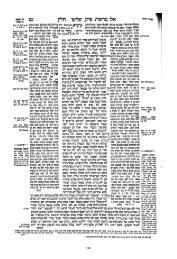Holy Shibuta: A fishy tale for Rosh Hashana - Halachic Adventures
Holy Shibuta: A fishy tale for Rosh Hashana - Halachic Adventures
Holy Shibuta: A fishy tale for Rosh Hashana - Halachic Adventures
Create successful ePaper yourself
Turn your PDF publications into a flip-book with our unique Google optimized e-Paper software.
Turkey<strong>Holy</strong> <strong>Shibuta</strong>A <strong>fishy</strong> <strong>tale</strong> <strong>for</strong> <strong>Rosh</strong> <strong>Hashana</strong>Imagine the great talmudic scholarRava, his mouth watering, thinkingabout the next bite of his Shabbat mealand knowing that it will taste like ham.That image is what brought us to a mostunusual meal, sitting in a <strong>for</strong>est overlookingthe Euphrates River in Turkey. Wedined with the provincial governor and afish expert from the University of Harranwith the apt name of Zafer Dogu, whilewe munched on a fish that in Arabic iscalled shabut.Our main quest on this journey thathad brought us to south central Turkeywas <strong>for</strong> lesser-known Jewish customs andtraditions, and while trawling <strong>for</strong> Jewishlore just 60 km. north of the Syrian border,we hit the mother lode. To understandthis fish’s <strong>tale</strong>, a bit of seining ofthe traditional sources is needed.As we sit down to our <strong>Rosh</strong> <strong>Hashana</strong>meal, Jews all around the world begintheir first course with foods that thatsymbolize hopefulness and dreams ofhappiness and peace <strong>for</strong> the comingFishing trip.Shibut expertZafer Doguflanked byGreenspan(left) andZivotofsky.• By ARI Z. ZIVOTOFSKYand ARI GREENSPANyear. The most common custom is thedipping of an apple into honey, symbolizingthat the impending yearshould be sweet. A less well known custom,but one with venerable andancient roots, is dipping a ram’s headin honey as a reminder of the bindingof Isaac and the anticipation of a pleasantyear.Another common custom is to eat thehead of a fish or ram, upon which wepronounce our desire that “we shouldbe as a head and not as a tail.” Manypeople also eat fish and recite “may itbe Your will, our God who is the God ofour fathers, that we increase and multiplylike fish.”The fish in Judaism is seen as a particularlycommon and positive symbol.Fish bear many offspring and are asymbol of fertility. The protectiveshield used by mohelim, ritual circumcisers,is often made in the shape of afish because it represents fertility. Thebody of water where we say tashlich,the symbolic “casting of our sins intothe sea,” during this High <strong>Holy</strong> Dayseason, ideally should contain fishbecause fish are considered immune tothe “evil eye.” Because of this, fish isalso the symbol of the month of Adar.As opposed to animals, birds andgrasshoppers, no fish are named in theentire Bible. Talmudic literature doesmention several species by their commonnames, with the fish mentionedmost often being the shibuta. Whateverthis shibuta was, it was well known bythe Diaspora community of Babyloniaof old.The Talmud discusses shibuta in severalcontexts. We are told that the greatsages of the Talmud rolled up theirsleeves and involved themselves directlyin preparations <strong>for</strong> the Shabbat. Theamora Rava would personally salt theshibuta fish <strong>for</strong> the Shabbat meal. Wesurmise from this that the fish was wellknown and considered enough of a delicacyto be served <strong>for</strong> the Sabbathrepast.It is described as both having medicinalvalue or posing a health risk,depending on the season of the yearand the medical condition involved. Asalted head of shibuta boiled in beer is24 ROSH HASHANA 5768
The Mosque of Abraham in theancient part of Sanliurfa. According toMuslim tradition, King Nimrod wasangered by Abraham having smashedhis father’s idols, and had himcatapulted into a fiery furnace. God inHis benevolence miraculously causedthe fire to turn into water and thelogs into fish. And not just any fish,but shabut.(Courtesy photos)ROSH HASHANA 5768 25
Turkey‘State dinner.’ Clockwise from lower left: Ari Zivotofsky, shibut expert Zafer Dogu, Asst. Prof. Erdinç Sahinöz, Governor Mehmet Özel, Ari Greenspan and two traveling companions.a cure <strong>for</strong> a disease called yarkona (jaundice?).On the other hand, according tothe Gemara, eating the shibuta duringthe spring month of Nisan could causeleprosy.One of the more interesting referenceshas to do with the unique taste of thecreature. The Talmud relates that <strong>for</strong>everything that God prohibited in thisworld, He also created a counterpartthat was permitted. For example, bloodis prohibited, but the liver, which containsan abundance of the vital fluid,was permitted. Even though milk andmeat may not be eaten together, theudder of a lactating cow is permissible.Now here’s the kicker. The pig, themost detestable of animals to theJewish people, is of course <strong>for</strong>bidden asfood. However, should one have a penchantto taste the <strong>for</strong>bidden swine, weare in<strong>for</strong>med that the flavor of pork isidentical to (part of) the shibuta.FOR THE LAST few centuries the identityof the talmudic shibuta has puzzledEuropean scholars and at least ahalf dozen possible species have beenproposed. But it is no longer a mystery<strong>for</strong> us. Having an interest in Jewishculinary traditions, several years ago Iasked an Iraqi-born Tel Aviv cab driverwhich kosher birds they used to eat inhis native land. When the nostalgia ofhis youth warmed hissoul, he smiled andsaid that by far thetastiest item in theircuisine was neitherfowl nor meat, but afish called the shabut.His response electrifiedme. Could his shabutin Arabic be the shibutaof the Talmud?As I later discovered,the great rabbinicleader of BaghdadiJewry from the early20th century, RabbiYosef Haim (known asthe Ben Ish Hai) hadno doubt. He listed thefive most commonkosher fish eaten inBaghdad and aftermentioning the shabut he says “that isthe shibuta of the Talmud.” So herewas the shibuta – it is a type of carpknown in Arabic as shabut and by thescientific name Barbus grypus, from thefamily Cyprinidae (carps and minnows).A lot of explainingand laughing went onin security offices thatday, and we gave anew meaning to flyingfish. They found it soamusing (and we werethe only passengers insight) that they evenpermitted us tophotograph the X rayof the shibutaThe Europeans were stymied becausethey were looking in Europe, while theshibuta of the Babylonian Talmud isobviously found inBabylonia, moderndayIraq.That taxi ride igniteda passion to beholdand maybe even tastethis talmudic delicacy.We turned to thelargest collection ofpreserved fish in thecountry, a true nationaltreasure located atHebrew University inJerusalem, but alas, itwas lacking shibuta.The next step wouldbe more difficult andwas our conundrum:The fish lives in theTigris and Euphratesrivers, which flowthrough Iraq, Iran andSyria and are not readily accessible toIsraelis. But with the help of severalparties outside of Israel, we managed toget our first few shibuta shipped fromits natural territory via a third country.The trouble was that they were preservedin <strong>for</strong>maldehyde, so we couldnot get a taste. A side benefit was thatwe were able to donate a Barbus grypusto the Hebrew University collection.Our desire <strong>for</strong> a frozen sample to eat on<strong>Rosh</strong> <strong>Hashana</strong> was not quelled. Travel toIraq, Iran and Syria may be difficult <strong>for</strong> us,but there are many US military and civilianpersonal in Iraq and US army chaplainLt.-Col. Jeremy Steinberg is amongthem. He had already served a tour ofduty in Afghanistan and was serving hissecond tour in Iraq. Having known him<strong>for</strong> many years and knowing that he isgood at detective work (he has a <strong>for</strong>thcomingbook on Hebrew etymology), I e-mailed him about my search and finallyconvinced him that I was really seriousabout wanting him to find a shabut.He agreed to look, though doubtedthat he would be successful. But succeedhe did. He approached an Iraqiwho was employed on the US Armybase and asked him to find out aboutthe possibility of getting a shabut <strong>for</strong>him. The base, being near theEuphrates and the shabut being popular,the Iraqi returned the next morningnot with in<strong>for</strong>mation but with a boxcontaining two big and two small specimens.Chaplain Steinberg promptly26 ROSH HASHANA 5768
purchased the fish, recorded the eventwith many pictures that quicklyclogged my inbox, but alas the fish arestill in Iraq because we have not founda legal means to ship them from thereto Israel.OUR SEARCH was not over and took apositive turn when we “discovered”that the Tigris and Euphrates havetheir sources in a friendly country,Turkey. Quite <strong>for</strong>tuitously, I found notjust a fish expert but a Barbus grypusexpert, Dr. Zafer Dogu, from theDepartment of Fisheries, BozovaVocational School, Harran University.He was more than glad to cooperateand find a few fish <strong>for</strong> us. But thingsimproved even more when we contactedthe Turkish embassy, which graciouslyassisted us with arrangements<strong>for</strong> our trip to study the shibuta in theEuphrates, just a stone’s throw fromHarran, the city of our <strong>for</strong>efatherAbraham.We flew to Istanbul and from there toSanliurfa, landing on the longest runwayin Turkey in a deserted, brand newairport that was opened only the previousweek. One’s initial impressionupon arriving in this area near theEuphrates is that of the lush greenpatches irrigated by the majestic riveramong the otherwise moon-like landscapeof the harsh arid region of southcentralTurkey. We stepped out of theairport into 44º heat and proceeded tothe office of Governor Mehmet Özel,who warmly welcomed us and assistedus with all of our needs.After an initial meeting with the governor,the fish expert and his boss, wewere taken to a lake that was <strong>for</strong>medwhen the Atatürk Dam on theEuphrates was completed in 1993. Thedam, one of the largest in the world, ispart of the massive $32 billion publicproject known as the GreatSoutheastern Anatolia Project (GAP)that has greatly improved the standardof living in the region. The lake covers815 sq. km., and when it was filled <strong>for</strong>the first time it submerged 25 villages,displacing 55,000 inhabitants, and severalimportant unexplored archeologicalsites.Waiting <strong>for</strong> us on the lake were twoboats that took us to the middle of thisplacid body of water, where weobserved local fishermen pulling innets full of fish. Un<strong>for</strong>tunately, none ofthe fish caught while we were therewere shibuta. So as not to disappointus, Dogu, took out and prepared (verycooperatively according to our instructionsso that it remained kosher) one ofthe shibuta he had caught <strong>for</strong> us inadvance, and a lovely lakeside “statedinner” with the governor was held.From there, we were taken to see thefish research facility where work isbeing done on raising, among otherfish, the shibuta by, among others,Dogu who is a leading researcher onBarbus grypus sperm.Perhaps the most interesting aspectof the story came to light when wereached our hotel, an old stone structurebuilt right near an early Arab holysite called the Mosque of Abraham inthe ancient part of Sanliurfa. Accordingto Muslim tradition, King Nimrod wasangered by Abraham having smashedhis father’s idols, and had him catapultedinto a fiery furnace. God in Hisbenevolence miraculously caused thefire to turn into water and the logs intofish. And not just any fish, but shabut.On the site of the furnace-turned-pondan ancient church existed and then amosque was built.In 1896 this pool was visited by aChristian traveler who described theexperience (See http://armenianhouse.org/harris/armenia/letter11.html).“I was visiting, under guard of aTurkish soldier, the most beautiful partof Edessa, the fish-pond on the bordersof which stands the Mosque ofAbraham the friend of God, and aMoslem college. This college is the successorof the famous Christian schoolof Edessa, and the mosque, no doubt,marks the site of an ancient Christianchurch. The pool is full of fish, which itis prohibited under severe penalty tokill, and whichevery one feedswith bread andpennyworths ofparched corn. Sucha rush when youthrow it in! Theytumble over oneanother, and jumphalf out of thewater. Obviouslythe protection andsupport which thefish enjoy comesfrom a time whenthey were consideredsacred. So Iasked my soldierwhat was the nameof the fish, and hisanswer was, ‘InArabic they arecalled shabut.’”THIS WAS NOT theend of the story. Itwas time to take afish to Los Angeles<strong>for</strong> an OU “halachic dinner” to sharewith the rest of the Jewish world (seehttp://www.greenspandental.com/JewishJournal.com.html). But how couldwe get the fish into the US legally andwith it staying fresh? This turned outto not be a concern. We were in<strong>for</strong>medin an e-mail by the deputy chief ofTrade Operations, Customs and BorderProtection of the Port Authority of NewYork and New Jersey that “non livingfish [from Turkey] that are <strong>for</strong> personalconsumption and free from livepests/insects are not regulated and permittedentry.”Dogu’s boss, Asst. Prof. ErdinçSahinöz, confirmed the health status ofour fish. Going through security isoften a tense experience. In the isolated,new empty Sanliurfa airport, thesecurity people sat up straight in theirchairs and their eyes popped whenthey saw a large fish on the X-ray scanner.A lot of explaining and laughingwent on in security offices that day,and we gave a newmeaning to flyingfish. They found itso amusing (andwe were the onlyThe pig, the most detestableof animals to the Jewishpeople, is of course<strong>for</strong>bidden as food. However,should one have a penchantto taste the <strong>for</strong>bidden swine,we are in<strong>for</strong>med that theflavor of pork is identicalto (part of) the shibutaUS army chaplain Lt.-Col. Jeremy Steinberg goes fishing during his tour of duty in Iraq.passengers insight) that theyeven permitted usto photograph theX ray of the shibuta.Had our Turkishbeen better, wemight have founddry ice in Istanbul,but given its currentstate our preciouscargo waswrapped in regularice, hand carriedand stored inthe overhead bins,and off we went.The drippingwater weexplained to fellowpassengersmust be faulty airconditioningunits on the planes, andwe headed to LA hoping <strong>for</strong> the best. Itarrived still frozen, was masterfully preparedby the chef at the Prime Grillwith applesauce, instead of an apple inits mouth, and was willingly consumedat the Baron Herzog winery in Oxnardby a group of OU rabbis.The question we are often asked is“does it taste like pig?” Having nevertasted pork, we cannot personallyanswer that question. But the final verdictof the chef at the Prime Grill, afterfinding commonality between their texturesand consistency, was a definite“no.”What is interesting is that three differenttexts exist regarding the exactdescription of the shibuta’s taste. Onesource says the fish tastes like pig.Another says its brain does, and a thirdstates the tongue is the tasty morsel.Could the rabbis have been talkingtongue in cheek? As any angler will tellyou, the tongue or brain of a smallfreshwater fish is so tiny as to be almostnonexistent.Might the lesson be more along thelines of being satisfied with what wehave and transmitting to us that weshould not feel as if we are missinganything in this world? Basically, thelesson might be that if you feel like youare lacking, search far and hard enoughand you might even find what youthought you never could.As of now, the shibuta does not livein Israel. However, it has the potentialto, and indeed some of its close relativesdo. Two such species are Barbuslongiceps, a species that exists nowhereelse except the Kinneret and its tributaries,and Barbus canis, a fish found inthe Jordan River. This brings us to abeautiful midrash.As we start a new year and dream ofpeace and prosperity and of the days tocome, let us contemplate the eschatologicalmessage that the rabbis tell usthe shibuta has the potential to sharewith us. The midrash allegorically tellsus that when the Jews went into exileat the hands of the Babylonians, “700types of kosher fish, 800 types ofkosher locusts and an unlimited numberof kosher birds were exiled withthem to Babylonia, and when theyreturned all of them returned withthem except <strong>for</strong> the fish called theshibuta... and in the days to come, allare destined to return.”Shana Tova to all, and a year of greatfishing, wherever your pond may be.Ari Greenspan is a dentist in Jerusalemand Ari Zivotofsky teaches brain science atBar-Ilan University. For 25 years they havebeen halachic adventuring and researchingJewish traditions from communitiesaround the globe. For more in<strong>for</strong>mation,see www.greenspandental.com/links.php.ROSH HASHANA 5768 27


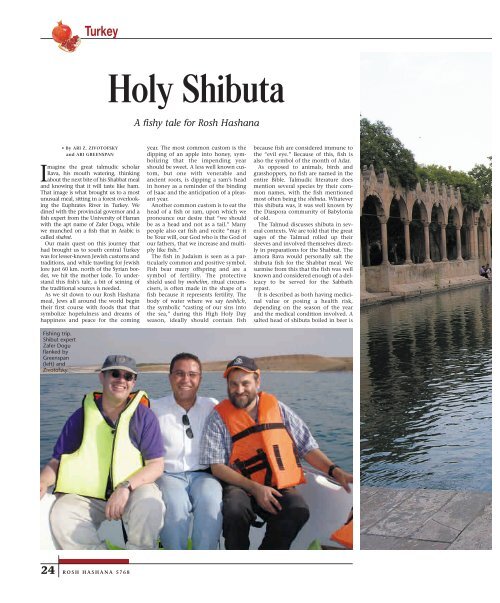

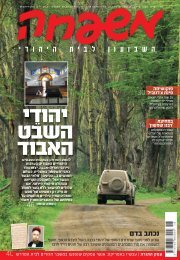

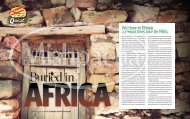

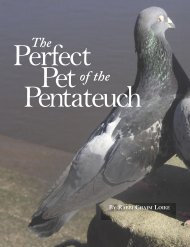
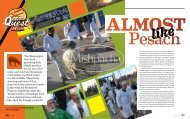

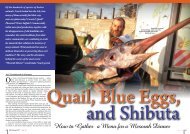
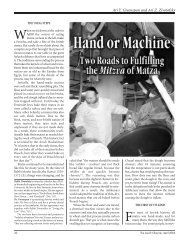
![llVtlwnl 1p1l 1biip 3 K11lnM o1it1 [1] - Halachic Adventures](https://img.yumpu.com/35271577/1/190x253/llvtlwnl-1p1l-1biip-3-k11lnm-o1it1-1-halachic-adventures.jpg?quality=85)

